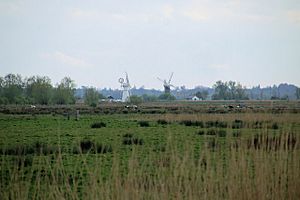Shallam Dyke Marshes, Thurne facts for kids
| Site of Special Scientific Interest | |
 |
|
| Area of Search | Norfolk |
|---|---|
| Interest | Biological |
| Area | 69.8 hectares (172 acres) |
| Notification | 1986 |
| Location map | Magic Map |
Shallam Dyke Marshes, Thurne is a special natural area in Norfolk, England. It covers about 69.8 hectares (that's like 172 football fields!). This place is super important for nature, especially for its unique plants and birds.
It's officially known as a Site of Special Scientific Interest (SSSI). This means it's one of the best places in the country for its wildlife or geology. Shallam Dyke Marshes is also part of bigger protected areas. These include the Broadland Ramsar site, a Special Protection Area (SPA), and a Special Area of Conservation (SAC). These titles show just how valuable this marshland is for nature.
Contents
What is a Grazing Marsh?
Shallam Dyke Marshes is a type of habitat called a "grazing marsh." Imagine a big, flat area of grassland that can sometimes get very wet. It's found in the valley of the River Thurne.
Historically, these marshes were used for grazing animals like cows. This grazing helps keep the grass short and creates the perfect environment for certain plants and animals to thrive.
Why are Grazing Marshes Important?
Grazing marshes are vital because they are home to many different kinds of wildlife. They act like natural sponges, holding water and helping to prevent floods. They also provide a safe place for birds to feed and raise their young.
Home to Amazing Wildlife
This marshland is a fantastic spot for birds, especially those known as "waders." Waders are birds with long legs that help them walk through shallow water or mud to find food.
Meet the Wading Birds
- Lapwings: These birds are easy to spot with their green-black feathers and crests on their heads. They make a distinctive "pee-wit" sound.
- Oystercatchers: Don't let their name fool you! While they do eat shellfish, they also enjoy worms and other small creatures. They have bright orange beaks and black and white feathers.
- Snipe: These shy birds are masters of camouflage, blending in perfectly with their marshy surroundings. They have long, straight beaks perfect for probing in the mud.
These birds rely on the wet, muddy conditions of the marsh to find their food and build their nests.
Special Plants to Discover
Shallam Dyke Marshes is not just about birds; it's also home to some very interesting and rare plants.
The Unique Water Soldier
One of the most special plants found here is the water soldier. This plant looks a bit like a spiky aloe vera plant floating on the water. It's quite rare in the UK.
The water soldier spends part of the year floating on the surface and then sinks to the bottom in winter. Its presence shows that the water quality in the marsh is very good.
Other Water Plants
You can also find a variety of other water plants here. These plants provide food and shelter for insects, which in turn are food for the birds. They all work together to create a healthy ecosystem.
Why is This Area Protected?
Shallam Dyke Marshes has several special titles that help protect it. These titles mean that the area is recognized for its importance to nature and that efforts are made to keep it healthy.
Site of Special Scientific Interest (SSSI)
Being an SSSI means the area has been identified as one of the best examples of a particular habitat, animal, or plant in the country. It gives the area legal protection.
Ramsar Site
A Ramsar site is a wetland of international importance. These sites are recognized globally for their role in supporting water birds and other wetland species.
Special Protection Area (SPA)
SPAs are areas protected under European law because they are important for wild birds, especially rare or vulnerable species.
Special Area of Conservation (SAC)
SACs are also protected under European law. They are chosen to protect a range of rare, endangered, or vulnerable natural habitats and species.
All these protections help make sure that Shallam Dyke Marshes remains a safe and thriving home for its amazing wildlife and plants for many years to come.

